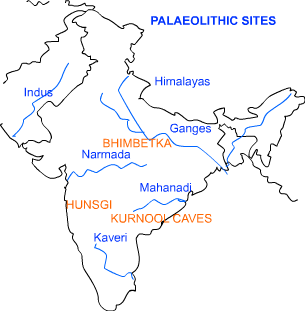NCERT Solutions for Class 6 History - On The Trail of the Earliest People
Let’s Recall
Q1. Complete the sentences:
(a) Hunter-gatherers chose to live in caves and rock shelters because______
Ans: They provided shelter from rain, heat and wind
(b) Grasslands developed around ______ years ago.
Ans: 12,000
(c) Early people painted on the ______ of caves.
Ans: Walls
(d) In Hunasagi, tools were made of ______
Ans: Stones
 Prehistoric Stone ToolsQ2. Look at the present-day political map of the Indian subcontinent. Find out the states where Bhimbetka, Hunsgi, and Kurnool are located.
Prehistoric Stone ToolsQ2. Look at the present-day political map of the Indian subcontinent. Find out the states where Bhimbetka, Hunsgi, and Kurnool are located.
Ans: Bhimbetka is in Madhya Pradesh, Hunsgi is in Karnataka and Kurnool is in Andhra Pradesh.
Let’s Discuss
Q3. Why did the hunter-gatherers travel from place to place? In what ways are these similar to/different from the reasons for which we travel today?
Ans:
The Ancient man moved from place to place mainly for four reasons,
- If he had stayed in the same place for the longest time, he would have used up all the resources like animals, plants, the water of that place. So they have to go to other places in search of food.
- Plants bear fruits, grains in particular seasons. So man moved to fetch his food accordingly.
- Animals do not stay in one place but they move in search of prey. Hence man moved along with the animals as the animals formed the food of man.
- Man needs water to perform almost all of his functions. Though some rivers were perennial (flow throughout the year) some were not so. Hence man had to move even in search of water.
Nowadays people travel for a variety of reasons like education, business, to meet friends and relatives and also for entertainment.
Q4. What tools would you use today for cutting fruit? What would they be made of?
Ans: We use knives for cutting and chopping the fruits, peelers for peeling fruits. These tools are made of stainless steel with wooden or plastic handles. Modern knives are very different from stone-age tools. Stone Age tools were made of stones with handles sometimes made of wood or bones.
Q5. List three ways in which hunter-gatherers used fire (see page 16). Would you use fire for any of these purposes today?
Ans:
The hunters-gatherers have used the fire for the following reasons:
- Scare the animals away
- Cooking
- Warm themselves from cold weather
- as a source of light
Nowadays, out of these reasons, we use fire for cooking and keeping us warm. Yes, We do use fire for cooking.
Let's Do
Q6. Make two columns in your notebook. In the left-hand column, list the foods hunter-gatherers ate. In the right-hand column, list some of the foods you eat. Do you notice any similarities/differences?
Answer:
| Column I Food eaten by early man | Column II Food eaten by modern man |
| Fruit, roots, nuts, seeds, leaves, stalks, eggs, meat | Processed food like bread, pizza, ice cream, etc. along with unprocessed food like fruit. |
Differences between the two eating habits: Today, we largely eat processed and cooked food, whereas the early people did not cook their food. They ate everything raw.
Q7. If you had a natural pebble-like like the ones shown on page 13 in the textbook, what would you use it for?
Ans: We can use the pebbles as decorative articles in the aquariums and gardens, for making jewelry, etc.
Q8. List two tasks that are performed by both men and women at present. List another two that are performed only by women, and two that are performed only by men. Compare your list with that of any two of your classmates. Do you notice any similarities/differences in your lists?
Ans:
Nowadays almost all the tasks are equally performed both by men and women. Still, there are few tasks that can be done only by men or women. The below are the lists,
- Two tasks performed both by men and women are teaching and cooking
- Two tasks performed only by women are nursing and feeding kids(Some tasks suit only women, though men too can perform equally)
- Two tasks performed only by men are mining and work in the shipyard (Some tasks suit only men, though women too can perform equally)
FAQs on NCERT Solutions for Class 6 History - On The Trail of the Earliest People
| 1. What is the significance of studying the earliest people? |  |
| 2. What are the important archaeological sites related to the earliest people? |  |
| 3. What were the tools used by the earliest people? |  |
| 4. What is the role of genetics in studying the earliest people? |  |
| 5. How did the earliest people adapt to their changing environment? |  |

















